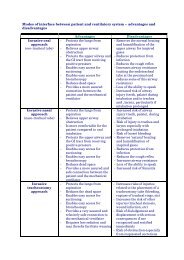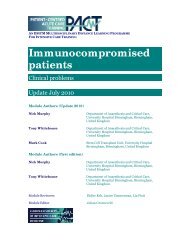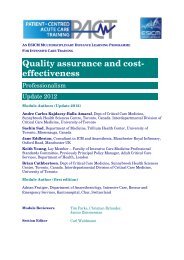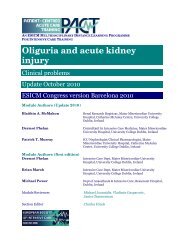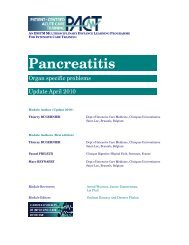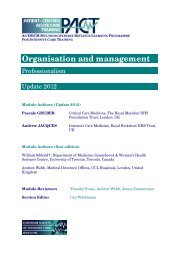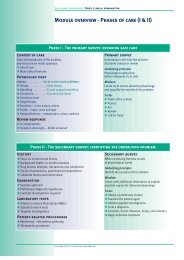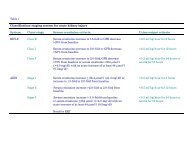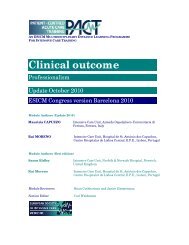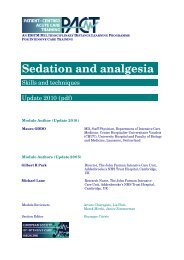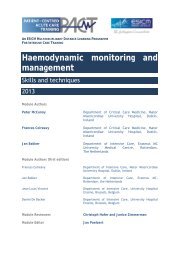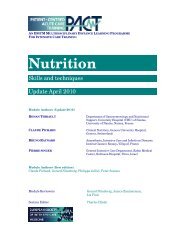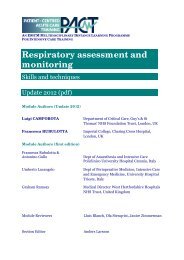Burns injury - PACT - ESICM
Burns injury - PACT - ESICM
Burns injury - PACT - ESICM
Create successful ePaper yourself
Turn your PDF publications into a flip-book with our unique Google optimized e-Paper software.
Removal of the burned tissue and wound closure as soon as possible is vital.<br />
Burned tissue is an ideal culture medium for bacteria and fungi, but even if not<br />
infected, the presence of burn tissue is a significant source of inflammatory<br />
mediators that support an ongoing systemic inflammatory response.<br />
Wound grafting<br />
The aim of the treatment is complete closure of the wound with autogenous split<br />
thickness skin grafts. If enough viable skin is available, skin grafting can be<br />
performed in the same operation after necrosectomy. In large burns, many surgeons<br />
prefer to do the necrosectomy and grafting in two procedures during two sequential<br />
days to make sure that necrosectomy is complete before grafting. Temporary<br />
coverage with cadaver skin or biological dressing as above may be necessary in larger<br />
burn wounds.<br />
In burns exceeding 40–50% TBSA, autologous cell cultures (keratinocytes, fibroblasts)<br />
may provide good coverage of the burned surface. The definitive role of this therapy<br />
is still to be confirmed.<br />
American Burn Association White Paper. Surgical Management of the Burn<br />
Wound and Use of Skin Substitutes<br />
Herndon DN, editor. Total Burn Care. 3rd edition. Edinburgh: Saunders-Elsevier;<br />
2007. ISBN 978-1416032748<br />
Wood FM, Kolybaba ML, Allen P. The use of cultured epithelial autograft in the<br />
treatment of major burn injuries: a critical review of the literature.<br />
<strong>Burns</strong> 2006; 32(4): 395–401. PMID 16621307<br />
Complications of fluid management (‘fluid creep’)<br />
The Parkland formulae (2-4 mL/kg/%TBSA) for burn <strong>injury</strong><br />
resuscitation was launched in the late sixties, and has been the<br />
cornerstone for fluid management in burns ever since. In later years<br />
there has been a tendency to give larger volumes of resuscitation<br />
fluid for a number of reasons:<br />
Fluid creep is the term<br />
created by Pruitt to<br />
describe fluid<br />
resuscitation in excess<br />
of that predicted by<br />
the Parkland formula<br />
and which is associated<br />
with compartment<br />
syndromes<br />
First, and possibly most important, is the use of central circulation surveillance<br />
techniques (pulse contour measurement and echocardiography) to assess fluid status<br />
of the patients in parallel to using the endpoints suggested by the Parkland formulae<br />
(urine output and mean arterial pressure). It is then evident that in the normal<br />
patient there is central circulation hypovolaemia if the Parkland formulae is adhered<br />
to, especially at 12 hrs post burn. Thus, conventional burn fluid resuscitation<br />
(Parkland formula) is a permissive ‘hypovolaemia’ strategy. Secondly, it is claimed<br />
that patients are currently more likely to be intubated and sedated with large doses<br />
of sedatives and analgesics. This practice leads indirectly to larger fluid volume<br />
needs to maintain blood pressure and urine output. Thirdly, as mortality for patients<br />
with the largest injuries is declining, resuscitative measures are more often<br />
16



